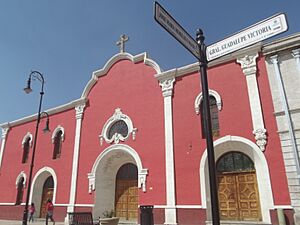San Esteban de Nueva Tlaxcala facts for kids
San Esteban de Nueva Tlaxcala was a special town in what is now the Mexican state of Coahuila. It was founded by people from Tlaxcala, an important group of indigenous people who were allies of the Spanish. San Esteban was the northernmost of six Tlaxcalan towns started in 1591. This happened because Luis de Velasco, who was like a governor for Spain in Mexico, asked them to. The people who founded San Esteban came from a place called Tizatlan. In 1834, San Esteban joined with the nearby city of Saltillo.
San Esteban was on the edge of Mexico, where there weren't many people and some indigenous groups were not friendly. The Tlaxcalans helped the Spanish settlers against these groups. But the Tlaxcalans also had their own independent society. San Esteban often had disagreements and legal fights with the Spanish settlers from Saltillo.
Contents
How San Esteban Began
San Esteban was created as part of a plan by the Spanish government. They wanted to end a long and difficult war called the Chichimeca War (1550-1590). They also wanted to control their northern borderlands. The Spanish decided to move 400 Tlaxcalan families to these areas where there was conflict. The Tlaxcalans were Christians and very loyal friends of the Spanish.
Why Tlaxcalans Were Important
The Tlaxcalans would help the Spanish protect their northern border. They would also help make peace with the Chichimeca tribes in a gentle way. They would teach them about Christianity and Spanish culture. The goal was to help these tribes change from being hunter-gatherers who moved around to farmers who stayed in one place.
Special Rights for Tlaxcalans
The 400 Tlaxcalan families moved to six different places. One of these was the Spanish settlement of Saltillo, which was struggling. Before they moved, the Spanish leaders and Tlaxcalan leaders talked for a long time. The Tlaxcalans asked for many special things, and they got them!
The most important thing was that their communities would be independent. This meant they would rule themselves and only answer to the main Spanish leader in Mexico City. They also received other special rights:
- They were seen as hidalgos, which meant "gentlemen." This was a special status they could pass down to their children.
- They didn't have to pay special taxes or do forced labor.
- No one could take their land or let their animals graze on it.
- They could carry weapons like Spaniards.
- They could ride horses with saddles and bridles, just like Spaniards.
Because of these rights, San Esteban was a unique town. It was "an independent municipality with special privileges." It was somewhere between a Spanish town and an indigenous town.
Founding the Town
In July 1591, 71 Tlaxcalan families and 16 single men arrived in Saltillo. They started the town of San Esteban on the west side of the Spanish settlement. Only an irrigation canal separated them from the Spanish. At that time, only 20 Spanish families lived in Saltillo. Their numbers were shrinking, and the town was in danger from Chichimeca attacks. So, the Tlaxcalans were welcomed with great excitement.
The Tlaxcalans armed their men to help defend Saltillo. They also sent a small group, usually 8 to 10 men, to join the Spanish on trips to control the nomadic tribes near Saltillo. Even though the Chichimeca War was mostly over, other nomadic tribes, like the Toboso, in northern Mexico continued to be unfriendly to the Spanish.
Keeping Their Culture Alive
The Spanish leader had asked the Tlaxcalans to help "civilize" the Chichimeca people. Several hundred Guachichils, who used to be enemies, were settled near San Esteban. They were given land as part of a peace deal. By 1677, San Esteban claimed the Guachichil land as their own. They said the Guachichils' children were "pure Tlaxcalan." By then, San Esteban had 1,750 people.
For more than 200 years, the Tlaxcalans in San Esteban tried to keep their culture pure. They did this out of pride and to keep their special rights. They mostly married within their own community. They also kept speaking their native language, Nahuatl. We know this because many Nahuatl documents, especially wills, from the 1600s still exist.
Tlaxcalan Help for Other Towns
San Esteban sent some of its people to help start a nearby town called Parras in 1598. In the 1600s and 1700s, they sent colonists to many other towns that were in danger from unfriendly indigenous people. These groups of Tlaxcalans usually had 10 to 14 families. This meant Tlaxcalans were spread out across the northern border of Mexico. The Spanish government gave these colonists tools and seeds. Sometimes, they even paid them money for their help. These Tlaxcalan colonists kept the same special rights they had in San Esteban de Nueva Tlaxcala.
Changes Over Time
A Spanish priest wrote in 1777 that San Esteban residents were hard-working. He said they hated being lazy and loved their farm work. They grew most of the vegetables and fruits eaten in nearby Saltillo. However, things started to change for San Esteban in the 1780s. More non-Tlaxcalan people moved to the area. There were also problems like unfriendly indigenous groups, dry weather, and diseases.
San Esteban slowly lost its independence. It started losing legal battles with the Spanish leaders of Saltillo. The town began to focus more on just surviving than on keeping its old rights.
Losing Independence
In the 1780s, the government changed how it was organized. This caused San Esteban to lose much of its ability to rule itself. Its traditional rights were further reduced after 1821, when Mexico became independent from Spain after the Mexican War of Independence. In 1827, San Esteban's name was changed. Then, in 1834, it was fully joined into the city of Saltillo.
See also
 In Spanish: San Esteban de Nueva Tlaxcala para niños
In Spanish: San Esteban de Nueva Tlaxcala para niños


